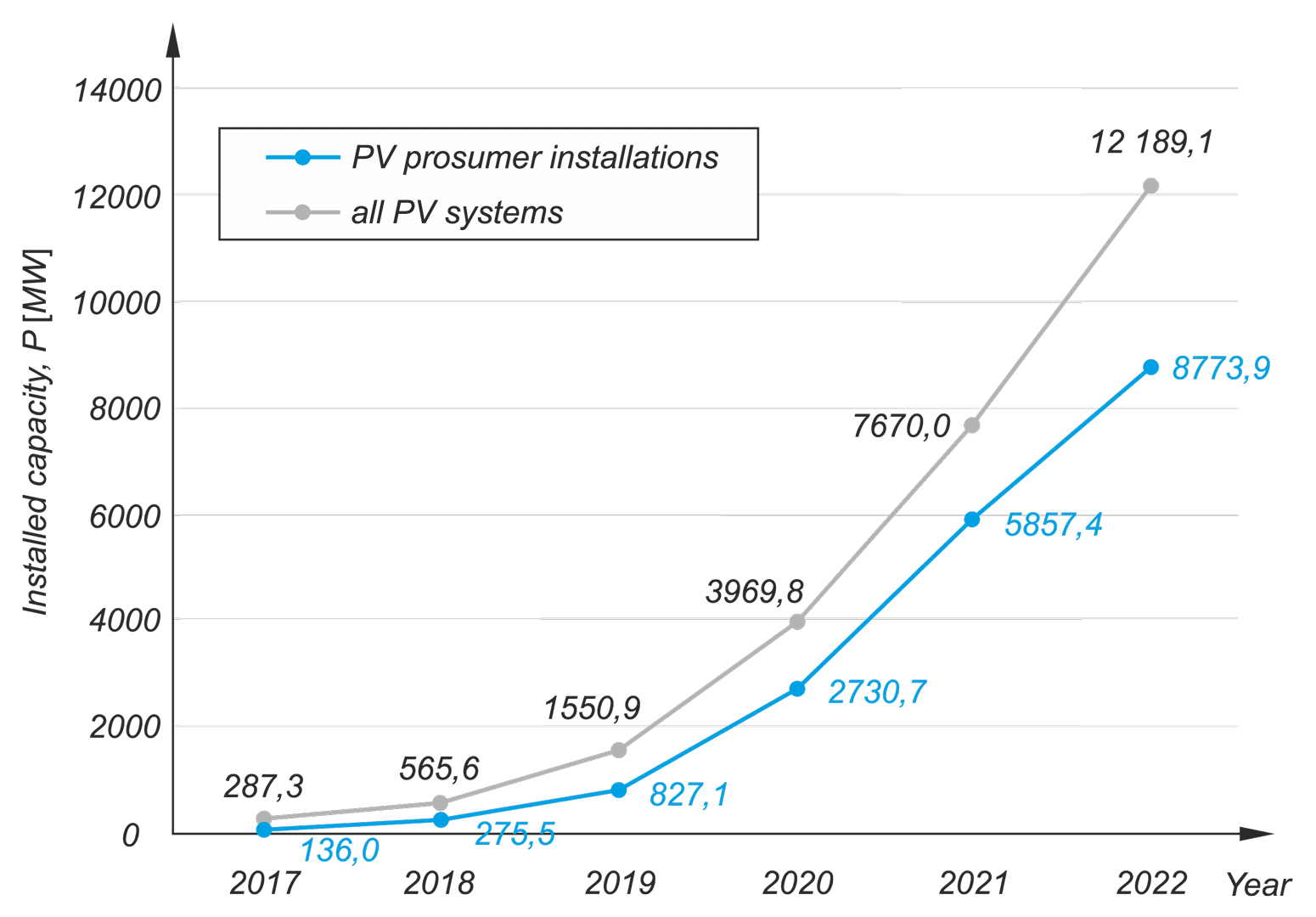E-journal for electrical and electronic engineers
AUTOMATYKA, ELEKTRYKA, ZAKLOCENIA
(AUTOMATICS, ELECTROTECHNICS, DISTURBANCES)
Vol. 14, nr 2 (52) 2023
Wykorzystanie neuronowej metody sterowania podobciążeniowym przełącznikiem zaczepów do poprawy warunków napięciowych w sieciach nn z generacją rozproszoną
Klara JANIGA, Robert JEDRYCHOWSKI
Abstract
The article deals with the issue of the phenomenon of voltage increase in distribution networks with a large share of photovoltaic prosumer installations. In the simulations for the exemplary low-voltage network, selected measures to prevent overvoltages were compared. An original method of controlling the transformers on-load tap changer based on an artificial neural network was also proposed. By using the proposed method, it is possible to make the operation of the tap changer dependent on the voltage conditions deep in the network, i.e. in nodes where problems with voltage increases occur.
Keywords
prosumer installations, photovoltaics, voltage control
Fig.
Bilbiography
[1] Ustawa z dnia 20 lutego 2015 r. o odnawialnych źródłach energii, Dz.U. 2015 poz. 478.
[2] „Informacja statystyczna, O energii elektrycznej”, Biuletyn miesięczny, Ministerstwo Klimatu i Środowiska, Agencja Rynku Energii S.A. (ARE), 12 (348), 2022.
[3] „Statystyka Elektroenergetyki Polskiej 2018”, Ministerstwo Klimatu i Środowiska, Agencja Rynku Energii S.A. (ARE), Warszawa, 2019.
[4] „Statystyka Elektroenergetyki Polskiej 2020”, Ministerstwo Klimatu i Środowiska, Agencja Rynku Energii S.A. (ARE), Warszawa, 2021.
[5] „Raport Rynek Fotowoltaiki w Polsce. XI edycja”, EC BREC Instytut Energetyki Odnawialnej (IEO), Warszawa, 2023.
[6] Ustawa z dnia 10 kwietnia 1997 r. – Prawo energetyczne, Dz.U. 1997 nr 54 poz. 348.
[7] B. Bletterie:„On the potential of voltage control to increase the hosting capacity of distribution networks”, Praca doktorska, Graz University of Technology, 2019.
[8] N. Jenkins, R. Allan, P. Crossley, D. Kirschen, G. Strbac: „Embedded generation”, IEEE Power and Energy Series, vol. 31, Londyn, The Institution of Engineering and Technology, 2000.
[9] R.A. Walling, R. Saint, R.C. Dugan, J. Burke, L.A. Kojovic: „Summary of Distributed Resources Impact on Power Delivery Systems”, IEEE Transactions on Power Delivery, 2008, vol. 23, no. 3, p. 1636 –1644.
[10] I. Wasiak, R. Pawełek: „Jakość zasilania w sieciach z generacją rozproszoną”, Warszawa, PWN, 2015.
[11] M.M. Haque, P. Wolfs: „A review of high PV penetrations in LV distribution networks: Present status, impacts and mitigation measures”, Renewable and Sustainable Energy Reviews, 2016, vol. 62, p. 1195–1208.
[12] „Mikroinstalacje w Polsce. Stan na 31 grudnia 2022 roku”. Polskie Towarzystwo Przesyłu i Rozdziału Energii Elektrycznej (PTPiREE). http://www.ptpiree.pl/energetyka-w-polsce/energetyka-w-liczbach/mikroinstalacje-w-polsce [dostęp: 1.08.2023].
[13] B. letterie, A. Gorsek, A. Abart, M. Heidl: „Understanding the Effects of Unsymmetrical Infeed on the Voltage Rise for the Design of Suitable Voltage Control Algorithms with PV Inverters”, [W:] 26th European Photovoltaic Solar Energy Conference and Exhibition, 2011, p. 4469–4478.
[14] L. Degroote, B. Renders, B. Meersman, L. Vandevelde: „Neutral-point shifting and voltage unbalance due to single-phase DG units in low voltage distribution networks”, [W:] PowerTech, 2009 IEEE Bucharest, Romania, 2009, p. 1–8.
[15] J. Hu, M. Marinelli, M. Coppo, A. Zecchino, H.W. Bindner: „Coordinated voltage control of a decoupled three-phase on-load tap changer transformer and photovoltaic inverters for managing unbalanced networks”, Electric Power Systems Research, 2016, vol. 131, p. 264–274.
[16] M.M. Haque, P. Wolfs: „A review of high PV penetrations in LV distribution networks: Present status, impacts and mitigation measures”, Renewable and Sustainable Energy Reviews, 2016, vol. 62, p. 1195–1208.
[17] S. Hashemi, J. Ostergaard: „Methods and strategies for overvoltage prevention in low voltage distribution systems with PV”, IET Renewable Power Generation, 2017, vol. 11, no. 2, p. 205–214.
[18] K. Janiga: „A review of voltage control strategies for low-voltage networks with high penetration of distributed generation”, IAPGOS, 2020, vol. 3, p. 60–65.
[19] N. Mahmud, A. Zahedi: „Review of control strategies for voltage regulation of the smart distribution network with high penetration of renewable distributed generation”, Renewable and Sustainable Energy Reviews, 2016, vol. 64, p. 582–595.
[20] T.J. Tengku Hashim, A. Mahomed, H. Shareef: „A review on voltage control methods for active distribution networks”, Przegląd Elektrotechniczny, 2012, vol. 88, no. 6, p. 304–312.
[21] A. Szultka, S. Szultka, S. Czapp, R. Karolak, M. Andrzejewski, J. Kapitaniak, M. Kulling, J. Bonk: „Voltage Profiles Improvement in a Power Network with PV Energy Sources – Results of a Voltage Regulator Implementation” Energies, 2022, vol. 15, no. 3 (723), p. 1–14.
[22] M.Z. ul. Abideen, O. Ellabban, S,S, Refaat, H. Abu-Rub, L. Al-Fagih: „A Novel Methodology to Determine the Maximum PV Penetration in Distribution Networks”, [W:] 2nd International Conference on Smart Grid and Renewable Energy (SGRE), 2019, p. 1–6.
[23] A. Ellis: „Grid Operations and High Penetration PV”, [W:] Utility/Lab Workshop on PV Technology and Systems, Arizona, 2010.
[24] A. Nguyen, M. Velay, J. Schoene, V. Zheglov, B. Kurtz, K. Murray, B. Torre, J. Kleissl: „High PV penetration impacts on five local distribution networks using high resolution solar resource assessment with sky imager and quasi-steady state distribution system simulations”, Solar Energy, 2016, vol. 132, p. 221–235.
[25] M. Wajahat. H.A. Khalid, G.M. Bhutto, C. Leth Bak: „A Comparative Study into Enhancing the PV Penetration Limit of a LV CIGRE Residential Network with Distributed Grid-Tied Single-Phase PV Systems”, Energies, 2019, vol. 12, no. 15 (2964), p. 1–17.
[26] „Photovoltaic (PV) Solar Panel Energy Generation data.” UK Power Networks. https://data.london.gov.uk/dataset/photovoltaic--pv--solarpanel-energy-generation-data [dostęp: 27.03.2023].
[27] Instrukcja Ruchu i Eksploatacji Sieci Dystrybucyjnej (IRiESD). Tekst jednolity obowiązujący od dnia 20 lutego 2023 r. Załącznik nr 1: „Szczegółowe wymagania techniczne dla jednostek wytwórczych przyłączanych i przyłączonych do sieci dystrybucyjnej.” PGE Dystrybucja S.A. https://pgedystrybucja.pl/strefa-klienta/przydatne-dokumenty/akordeon-przydatne-dokumenty/instrukcja-ruchu-i-eksploatacji-siecidystrybucyjnej [dostęp: 17.03.2023].
[28] K. Janiga: „Overvoltage protection of PV microinstallations – regulatory requirements and simulation model”, IAPGOS, 2021, vol. 2, p. 40–43.
[29] W. Hellmann. Z. Szczerba: „Regulacja częstotliwości i napięcia w systemie elektroenergetycznym”, WNT, 1978.
[30] J. Korpikiewicz: „Budowa modelu symulacyjnego regulatora przełączników zaczepów transformatora WN/SN – kompensacja prądowa”, Pomiary Automatyka Robotyka, 2018, vol. 22, no. 4, p. 51–59.
[31] R. Małkowski: „Transformatory z regulacją przekładni pod obciążeniem w systemie elektroenergetycznym – zagadnienia wybrane”, Gdańsk, Wydawnictwo Politechniki Gdańskiej, 2019.
[32] M.O. Moreira, P.P. Balestrassi, A.P. Paiva, P.F. Ribeiro, B.D. Bonatto: „Design of experiments using artificial neural network ensemble for photovoltaic generation forecasting”, Renewable and Sustainable Energy Reviews, 2021, vol. 135, p. 1–14.
[33] M.N. Akhter, S. Mekhilef, H. Mokhlis, N. Mohamed Shah: „Review on forecasting of photovoltaic power generation based on machine learning and metaheuristic techniques”, IET Renewable Power Generation, 2019, vol. 13, no. 7, p. 1009–1023.
[34] B. Li, C. Delpha, D. Diallo, A. Migan-Dubois: „Application of Artificial Neural Networks to photovoltaic fault detection and diagnosis: A review”, Renewable and Sustainable Energy Reviews, 2021, vol. 138, p. 1–23.
[35] M. Dashtdar, R. Dashti, H.R. Shaker: „Distribution network fault section identification and fault location using artificial neural network”, [W:] 5th International Conference on Electrical and Electronic Engineering (ICEEE), Turkey, 2018, p. 273–278.
[36] T. Kerdphol, R.N. Tripathi, T. Hanamoto, Khairudin, Y. Qudaih, Y, Mitani: „ANN based optimized battery energy storage system size and loss analysis for distributed energy storage location in PV-microgrid”, [W:] IEEE Innovative Smart Grid Technologies – Asia (ISGT ASIA), Bangkok, Thailand, 2015, p. 1–6.
[37] J. Kaushal, P. Basak: „Power quality control based on voltage sag/swell, unbalancing, frequency, THD and power factor using artificial neural network in PV integrated AC microgrid”, Sustainable Energy, Grids and Networks, 2020, vol. 23, p. 1–23.
[38] S. Osowski: „Sieci neuronowe w ujęciu algorytmicznym”, Warszawa, WNT, 1996.
[39] „Transformer tap changer – QDSL model.” FAQ-Reader PowerFactory. https://www.digsilent.de/en/faq-reader-powerfactory/How-can-Icontrol-the-tap-changer-of-a-transformer-in-a-QDSL-model.html [dostęp: 30.05.2023].


















































